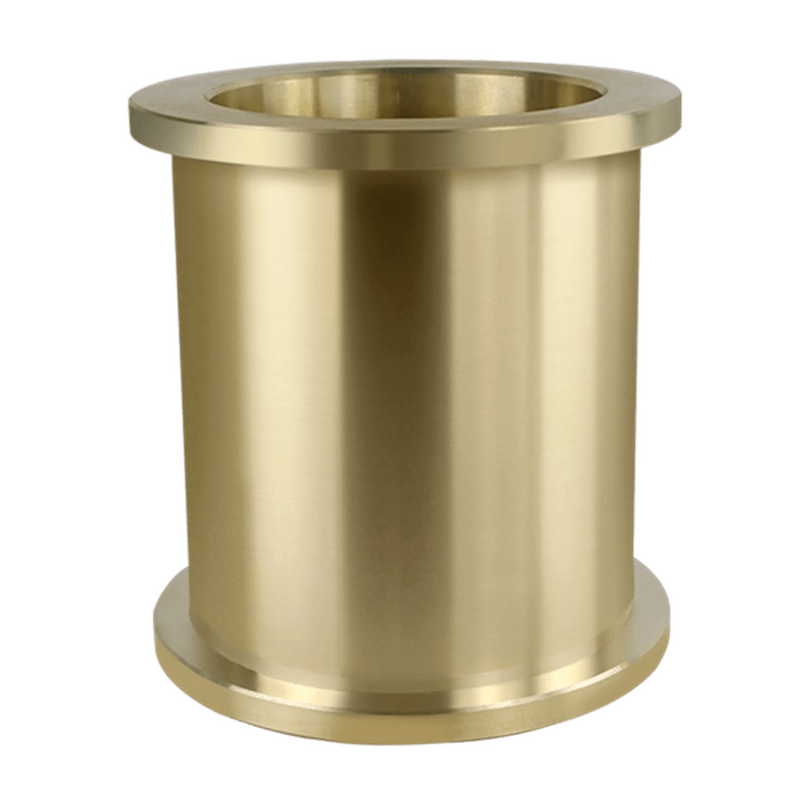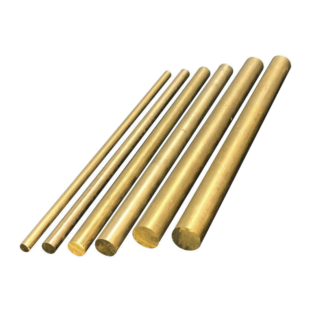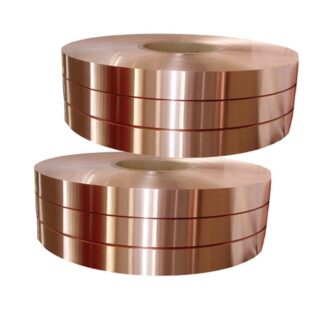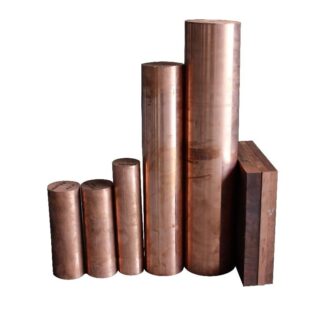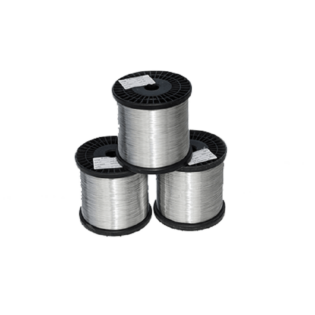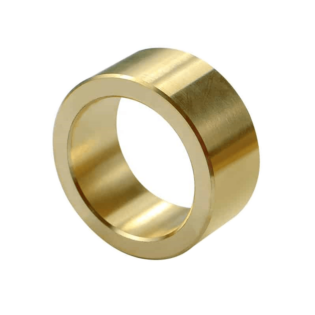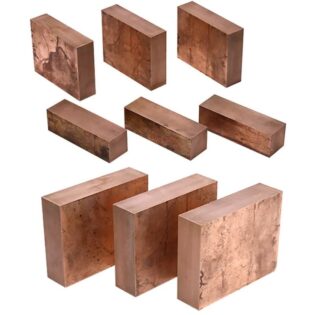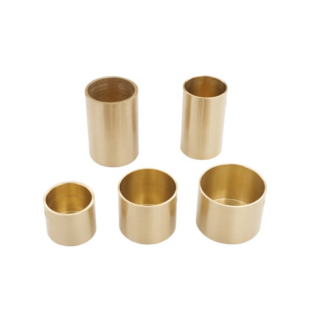AMS 4880-C95510 Nikel Alüminyum Bronz Ürün Tanıtımı
Kimyasal bileşim
| Öğe | Yüzde (%) | Alaşımdaki Rolü |
|---|
| Cu | 78.00 dakika | Birincil bileşen, temel yapı ve özellikleri sağlar |
| sn | 00,20 maksimum | Korozyon direncini ve gücünü artırır |
| Zn | 00,30 maksimum | Gücü arttırır ve deoksidan görevi görür |
| Fe | 2.00-3.50 | Tane yapısını iyileştirir ve mukavemeti artırır |
| İçinde | 4.50-5.50 | Korozyon direncini ve mekanik özellikleri iyileştirir |
| Al | 9.70-10.90 | Metallerarası bileşikler oluşturarak mukavemeti ve aşınma direncini artırır |
| Mn | Maksimum 1,50 | Mukavemeti artırır ve alaşımı deoksidize eder |
Not: Cu + adı geçen elementlerin toplamı, �,8 min. Ni değeri Co'yu içerir. Aksi belirtilmediği sürece tekli değerler maksimumları temsil eder.
Mekanik özellikler
| Mülk | Castings <4.0, Heat Treated | Dökümler 4.0+, Isıl İşlem Görmüş |
|---|
| Çekme mukavemeti, min | 105,0 ksi (724 MPa) | 95,0 ksi (655 MPa) |
| Verim gücü (%0,2 Ofset), min | 62,5 ksi (431 MPa) | 56,0 ksi (386 MPa) |
| 4D'de uzama, min | %9 | %9 |
| Brinell sertliği | 192 ila 248 BHN | 192 ila 248 BHN |
Farklı Sıcaklıklarda Performans
| Sıcaklık Aralığı | Performans Özellikleri |
|---|
| Düşük Sıcaklıklar (-50°C ila 0°C) | İyi süneklik ve tokluğu korur |
| Oda Sıcaklığı (20°C ila 25°C) | Mukavemet ve sünekliğin optimum dengesi |
| Orta Sıcaklıklar (100°C ila 200°C) | İyi sertliği ve aşınma direncini korur |
| Yüksek Sıcaklıklar (200°C ila 300°C) | Mukavemette hafif bir azalma, ancak iyi korozyon direncini korur |
| Yüksek Sıcaklıklar (300°C ila 400°C) | Azaltılmış mekanik özellikler, ancak yine de bazı uygulamalarda kullanılabilir |
Endüstri Uygulamaları
| Endüstri sektörü | Özel Uygulamalar |
|---|
| Havacılık | Uçak yapılarında iniş takımı burçları, yataklar |
| Deniz | Deniz suyu sistemlerinde pervaneler, pompa çarkları, valf bileşenleri |
| Yağ ve gaz | Açık deniz platformu bileşenleri, deniz altı ekipmanları |
| Otomotiv | Süspansiyon sistemlerindeki burçlar, dişli kutusu bileşenleri |
| Endüstriyel Makineler | Ağır makinelerde aşınma plakaları ve burçlar |
| madencilik | Pompa bileşenleri, konveyör sistemi parçaları |
| Güç üretimi | Enerji santrallerinde türbin bileşenleri, valf yuvaları |
Şekil ve Boyut Kullanılabilirliği
| Biçim | Boyut aralığı | Notlar |
|---|
| Katılar | 1/2" ila 9" O.D. | – |
| Tüpler | 1 1/8" ila 13" dış çap | Duvar kalınlığı için değirmene danışın |
| Dikdörtgenler | 15'e yükselmek" | – |
| Standart uzunluklar | 24" | Diğer uzunluklar için değirmene danışın |
| Çubuk Stoku | Çeşitli çaplar | Yuvarlak, altıgen ve kare şekillerde mevcuttur |
| Plaka | 6" kalınlığa kadar | Genişlik ve uzunluk kalınlığa göre değişir |
| Dövmeler | Özel boyutlar | Spesifikasyonlara göre sipariş üzerine yapılır |
Üretim Standartları
| Standart | Tanım |
|---|
| AMS4880 | Nikel Alüminyum Bronz için Havacılık ve Uzay Malzemesi Şartnamesi |
| ASTM B150 | Alüminyum Bronz Çubuk, Çubuk ve Şekiller için Standart Şartname |
| ASTM B171 | Basınçlı Kaplar, Kondansatörler ve Isı Eşanjörleri için Bakır Alaşımlı Plaka ve Levha için Standart Şartname |
| SAE J461 | Ferforje Bakır ve Bakır Alaşımlı Eşanjör Borusu |
| MIL-B-21230 | Bronz, Alüminyum için Askeri Şartname |
Farklı Ülkelerdeki Standartlar ve Karşılık Gelen Sınıflar
| Ülke/Bölge | Standart/Sınıf | Eşdeğer Tanım |
|---|
| Amerika Birleşik Devletleri | AMS4880-C95510 | ABD C95510 |
| Avrupa | EN 1982-CC333G | CuAl10Ni5Fe4 |
| Japonya | HE H5120-CAC703 | – |
| Çin | GB/T 5231-QAl9-4 | – |
| Rusya | GOST 493-79 Derecesi BrA9Zh4N4 | – |
| Hindistan | IS 3091 Sınıf 2 | – |
| Avustralya | AS 2074-CA953 | – |
Kaynak, İşleme, Parlatma, Isıl İşlem, Soğuk İşleme
Kaynak
| Kaynak Yöntemi | Uygunluk | Notlar |
|---|
| Gaz Tungsten Ark Kaynağı (GTAW/TIG) | Harika | Yüksek kaliteli kaynaklar için tercih edilen yöntem |
| Gazaltı Metal Ark Kaynağı (GMAW/MIG) | İyi | Daha büyük bileşenler için uygundur |
| Korumalı Metal Ark Kaynağı (SMAW) | Adil | Kullanılabilir ama tercih edilmez |
| Elektron Işın Kaynağı | Harika | Havacılık ve uzay uygulamalarında hassas kaynak için |
| Sürtünme Karıştırma Kaynağı | İyi | Katı hal birleştirme için yeni ortaya çıkan yöntem |
İşleme
| İşleme Yöntemi | İşlenebilirlik Derecelendirmesi | Notlar |
|---|
| Tornalama | 50 (0-100 ölçek) | En iyi sonuçlar için karbür takımları kullanın |
| Frezeleme | 50 (0-100 ölçek) | Orta düzeyde kesme hızları önerilir |
| Sondaj | 50 (0-100 ölçek) | Yüksek hız çeliği veya karbür matkaplar kullanın |
| Bileme | İyi | Sıkı toleranslara ulaşmak için uygundur |
| Elektrik Boşaltma İşleme (EDM) | Harika | Karmaşık şekiller ve profiller için |
Parlatma
| Parlatma Yöntemi | Ulaşılabilir Bitirme | Notlar |
|---|
| Mekanik Parlatma | Ayna kaplama | Aşamalı olarak daha ince aşındırıcılar kullanın |
| Elektro-parlatma | Yüksek parlaklık | Karmaşık geometrilere uygun |
| Parlatma | Yüksek parlaklık | Dekoratif uygulamalar için son adım |
Isı tedavisi
| Isıl İşlem Prosesi | Sıcaklık Aralığı | Amaç |
|---|
| Çözüm Tavlama | 870-900°C | Mikroyapıyı homojenleştirin |
| Söndürme | Oda sıcaklığına hızlı soğutma | Gücü ve sertliği artırın |
| Yaşlanma | 350-400°C 2-4 saat | Mekanik özellikleri iyileştirin |
| Stres Giderme | 350-400°C 1-2 saat | İç gerilimleri azaltın |
Soğuk İşleme
| Soğuk İşleme Yöntemi | Malzeme Üzerindeki Etki | Uygulamalar |
|---|
| Soğuk Haddeleme | Gücü ve sertliği artırır | Levha ve şerit üretimi |
| Soğuk Çekme | Yüzey kalitesini ve boyutsal doğruluğu iyileştirir | Tel ve boru üretimi |
| Soğuk dövme | Mekanik özellikleri geliştirir | Net'e yakın şekil bileşenleri |
Malzemelerin Avantajları ve Dezavantajları
Avantajları
| Avantaj | Tanım |
|---|
| Yüksek güç | Diğer birçok bakır alaşımıyla karşılaştırıldığında mükemmel çekme ve akma dayanımı |
| Aşınma direnci | Aşınma ve sürtünmeye karşı üstün direnç |
| Korozyon Direnci | Deniz suyuna ve birçok kimyasala karşı iyi direnç |
| Termal iletkenlik | Paslanmaz çeliklerden daha iyi, ısı değişim uygulamalarına uygundur |
| Kıvılcım çıkarmayan | Patlayıcı ortamlarda kullanım için güvenli |
| Düşük Manyetik Geçirgenlik | Manyetik olmayan malzemeler gerektiren uygulamalar için uygundur |
Dezavantajları
| Dezavantaj | Tanım |
|---|
| Maliyet | Daha basit bakır alaşımlarından veya çeliklerden daha pahalıdır |
| Ağırlık | Bazı uygulamalarda sorun teşkil edebilecek alüminyum alaşımlarından daha ağırdır |
| Karmaşık İşleme | Döküm ve ısıl işlem sırasında dikkatli kontrol gerektirir |
| Sınırlı Süneklik | Saf bakırdan veya diğer bazı bakır alaşımlarından daha az sünektir |
| Gerilim Korozyonu Çatlaması Potansiyeli | Belirli çevresel koşullar altında ortaya çıkabilir |
Benzer Ürünler ve Karşılaştırma
Benzer Nikel Alüminyum Bronz Alaşımları
| Alaşım Tanımı | Kimyasal bileşim | Temel Farklılıklar |
|---|
| C95800 | Cu-9Al-4Fe-4Ni | Daha yüksek demir içeriği, biraz daha düşük mukavemet |
| C95700 | Cu-11Al-3Fe-5Ni | Daha yüksek alüminyum içeriği, artırılmış sertlik |
| C95400 | Cu-11Al-4Fe | Nikel yok, daha düşük korozyon direnci |
Diğer Malzeme Sınıflarıyla Karşılaştırma
| Malzeme | C95510'a göre avantajları | C95510'a kıyasla dezavantajları |
|---|
| Paslanmaz Çelik 316 | Daha düşük maliyet, daha yüksek kullanılabilirlik | Daha düşük ısı iletkenliği, daha yüksek ağırlık |
| Alüminyum Bronz (örn. C95400) | Daha düşük maliyet, dökümü daha kolay | Daha düşük mukavemet ve korozyon direnci |
| Fosfor Bronz | Daha iyi elektrik iletkenliği | Daha düşük mukavemet ve aşınma direnci |
| Titanyum Alaşımları | Daha düşük yoğunluk, daha yüksek mukavemet/ağırlık oranı | Çok daha yüksek maliyet, işlenmesi daha zor |
Detaylı Karşılaştırma Tablosu
| Mülk | AMS4880-C95510 | Paslanmaz Çelik 316 | Alüminyum Bronz C95400 | Titanyum Sınıf 5 (Ti-6Al-4V) |
|---|
| Çekme Dayanımı (MPa) | 655-724 | 515-690 | 586-758 | 895-930 |
| Akma Dayanımı (MPa) | 386-431 | 205-310 | 241-379 | 828-910 |
| Uzama (%) | 9 (dakika) | 40 | 12 | 10-15 |
| Yoğunluk (g/cm³) | 7.64 | 8.00 | 7.45 | 4.43 |
| Isıl İletkenlik (W/m·K) | 42 | 16.3 | 59 | 6.7 |
| Deniz Suyunda Korozyon Direnci | Harika | Harika | İyi | Harika |
| İşlenebilirlik (0-100 ölçek) | 50 | 50 | 60 | 30 |
| Göreli Maliyet | Yüksek | Ilıman | Ilıman | Çok Yüksek |
Ek Özellikler ve Özellikler
| Mülk | Değer | Birimler |
|---|
| Elektriksel Direnç | 14.4 | µΩ·cm |
| Özgül Isı Kapasitesi | 00,375 | J/g·°C |
| Erime aralığı | 1030-1060 | °C |
| Esneklik Modülü | 110-120 | not ortalaması |
| Poisson Oranı | 00,33 | – |
| Yorulma Dayanımı (10⁷ döngü) | 207-241 | MPa |
| Sönümleme Kapasitesi | Ilıman | – |
Çevresel ve Geri Dönüşüm Hususları
| Bakış açısı | Tanım |
|---|
| Geri dönüştürülebilirlik | Yüksek oranda geri dönüştürülebilir, yeniden eritilebilir ve yeniden kullanılabilir |
| Çevresel Etki | Birincil üretime kıyasla geri dönüşüm için daha düşük enerji gereksinimi |
| Toksisite | Katı formda toksik değildir ancak işleme sırasında oluşan toz ve duman kontrol edilmelidir. |
| Kullanım Ömrü Sonu | Yerleşik metal geri dönüşüm kanalları aracılığıyla toplanıp geri dönüştürülebilir |
Kalite Kontrol ve Test Yöntemleri
| Test metodu | Amaç | Standart |
|---|
| Çekme Testi | Mukavemet ve sünekliği belirleyin | ASTM E8 |
| Sertlik Testi | Yüzey sertliğini ölçün | ASTM E10 (Brinell) |
| Kimyasal analiz | Kompozisyonu doğrulayın | ASTM E478 |
| Ultrasonik Test | Dahili kusurları tespit edin | ASTM E114 |
| Radyografik Test | Gözeneklilik ve kalıntılar açısından inceleyin | ASTM E1742 |
| Korozyon Testi | Korozyon direncini değerlendirin | ASTM G31 |
Depolama ve Taşıma Önerileri
| Bakış açısı | Tavsiye |
|---|
| Depolama Ortamı | Kimyasallardan uzak, kuru ve temiz alan |
| Taşıma | Ağır parçalar için uygun kaldırma ekipmanı kullanın |
| Koruma | Yüzey hasarını önlemek için koruyucu kaplamalar veya sargılar uygulayın |
| Envanter Yönetimi | Stok yönetimi için FIFO (İlk Giren İlk Çıkar) sistemini kullanın |
| Güvenlik Önlemleri | İşleme sırasında, özellikle kesme veya işleme sırasında uygun KKD kullanın |
Tipik Teslim Süreleri ve Fiyatlandırma Faktörleri
| Faktör | Tanım |
|---|
| Standart Stok Büyüklükleri | Genellikle 1-2 haftalık teslim süresiyle mevcuttur |
| Özel Boyutlar/Şekiller | 4-8 hafta teslim süresi gerektirebilir |
| Miktar | Daha büyük siparişlerin teslim süreleri daha uzun olabilir ancak daha iyi fiyatlandırma olabilir |
| Piyasa Koşulları | Bakır ve nikel fiyatları nihai maliyeti önemli ölçüde etkileyebilir |
| Sertifika Gereksinimleri | Özel sertifikalar teslim süresini ve maliyetini artırabilir |
Çözüm
AMS 4880-C95510 Nikel Alüminyum Bronz, mukavemet, aşınma direnci ve korozyon direncinin mükemmel bir kombinasyonunu sunan yüksek performanslı bir alaşımdır. Çok yönlülüğü, özellikle denizcilik ve havacılık ortamlarında olmak üzere çeşitli endüstrilerde geniş bir uygulama yelpazesine uygun olmasını sağlar. Diğer bazı malzemelerle karşılaştırıldığında daha yüksek bir başlangıç maliyetine sahip olsa da, uzun vadeli performansı ve dayanıklılığı çoğu zaman kritik bileşenler için daha düşük yaşam döngüsü maliyetleriyle sonuçlanır. Malzemenin çeşitli çalışma koşullarında özelliklerini koruyabilmesi ve kıvılcım çıkarmama özelliği, onu güvenlik açısından kritik uygulamalarda tercih edilen bir seçim haline getiriyor. Herhangi bir özel malzemede olduğu gibi, yeteneklerini tam olarak geliştirmek ve hizmet ömrü boyunca en iyi performansı sağlamak için tasarım, işleme ve bakıma uygun şekilde dikkat edilmelidir.
